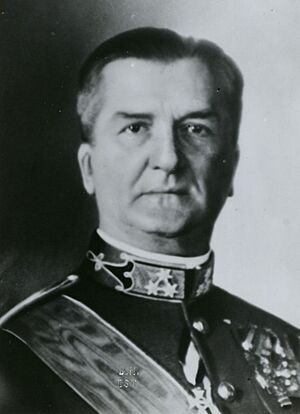Regent of Hungary facts for kids
Quick facts for kids Regent of Hungary |
|
|---|---|

|
|
| Style | His Serene Highness |
| Residence | Buda Castle |
| Appointer | Royal Diet |
| Term length | No fixed term |
| Formation | 1446 (historic) 1 March 1920 |
| Final holder | Miklós Horthy |
| Abolished | 15 October 1944 |
| Deputy | István Horthy (19 February – 20 August 1942) |
The regent of Hungary was an important leader in Hungary. This position was first created in 1446 and then brought back in 1920. A regent acts as the head of state when there is no king or queen.
From 1920 until 1944, Admiral Miklós Horthy held this powerful role. He was the leader of the post-World War I state known as the Kingdom of Hungary. While a prime minister managed the government, Horthy served as the head of the country. He was officially called "His Serene Highness the Regent of the Kingdom of Hungary."
Contents
History of the Regent Position
The role of a regent in Hungary has a long history. It was used when a king was too young, absent, or when the country was between rulers.
Past Hungarian Regents
John Hunyadi: A Warrior Regent

In 1439, King Albert of Hungary died suddenly. John Hunyadi believed Hungary needed a strong warrior king. He supported Władysław III of Varna, the King of Poland, to become the new Hungarian king in 1440. This led to a conflict with a powerful noble, Ulrich II of Celje.
Hunyadi's military skills helped Władysław III win the short civil war. As a reward, Hunyadi was made captain of the important Belgrade fortress. In 1445, a temporary government was set up, and Hunyadi was given control over a large area.
Because the country was in chaos, Hunyadi was elected regent of Hungary on June 5, 1446. He ruled in the name of the young King Ladislaus V. Hunyadi used his power to try and free Ladislaus V from the German king Frederick III, Holy Roman Emperor.
Mihály Szilágyi: Regent for a Young King
On January 20, 1458, Matthias Corvinus, the son of John Hunyadi, was chosen as king by the Hungarian Parliament. This was a big deal because Matthias was a noble, not from a royal family. It showed that Parliament was becoming very powerful.
Since Matthias was young, the Parliament appointed his uncle, Mihály Szilágyi, as regent. Szilágyi was supposed to help the young king rule. However, Matthias quickly showed he was a strong leader. He removed Szilágyi from his post and began to rule on his own.
Lajos Kossuth: Governor-President
During the Hungarian Revolution of 1848, the new Emperor Francis Joseph I of Austria took away rights that Hungary had gained. He declared Lajos Kossuth and the Hungarian government illegal.
In April 1849, after many Hungarian victories, Kossuth announced Hungary's independence. He declared that the Habsburg royal family had lost their right to rule Hungary. Kossuth became the head of state, called the Governor-President of Hungary. This decision made it very hard for Hungary to make peace with the Habsburgs.
Hungary After World War I
After World War I, the large Austria-Hungary empire broke apart. Hungary became a republic for a short time. There was a period of unrest, including a communist government that led to a war with Romania.
By 1920, the country was in civil conflict. Anti-communists and monarchists fought against communists and others they saw as threats. After Romanian forces left, the Kingdom of Hungary was restored.
On March 1, 1920, the Hungarian National Assembly brought back the Kingdom of Hungary. However, the countries that won World War I did not want the old Habsburg royal family to return to the throne. So, instead of a king, they needed a regent.
Admiral Horthy, who had been a commander in the navy, was chosen. He was also the Minister of War and commander of the National Army. The assembly voted to make him the new Regent of Hungary.
When Horthy was offered the job, he said he would only accept if his powers were increased. The politicians agreed, giving him many of the powers a king would have. These included choosing and firing prime ministers, calling or ending parliament meetings, and leading the armed forces. With these wide-ranging powers, Horthy took his oath as regent.
What the Regent Did
Hungary was legally a kingdom, but it did not have a king. The winning countries of World War I would not allow the old royal family to return. Hungary kept its parliamentary system, with a prime minister leading the government.
As head of state, Regent Horthy had a lot of power. He could influence laws and make sure they matched his political ideas. His ministers were also very loyal to him.
The End of the Regency
During World War II, Hungary joined forces with Nazi Germany. As the war started to go badly for Germany, Hungary tried to distance itself from the war. Germany worried that Hungary might leave their side.
In March 1944, German forces occupied Hungary to keep them in the war. Horthy was allowed to stay as regent, but he had to appoint a prime minister who would obey the Germans.
After Romania left the Axis powers in August 1944, Horthy secretly began talking with the Soviet Union. On October 15, 1944, Horthy announced on the radio that Hungary had signed a peace agreement with the Soviets.
Germany reacted quickly with an operation called Operation Panzerfaust. They arrested Horthy and his son, Miklós. Horthy was forced to sign a statement giving up his power and handing control to Ferenc Szálasi. Szálasi was the leader of the pro-Nazi Arrow Cross Party. Horthy later said he only signed to save his son's life.
Szálasi led the government from October 1944 to March 1945. He became the "National Leader," acting as both head of state and head of government. While Horthy's regency ended, the Hungarian monarchy was not officially abolished by Szálasi. The need for a regent ended when the Kingdom of Hungary was replaced by the Second Hungarian Republic on February 1, 1946.
See also
- King of Hungary
- List of rulers of Hungary
- List of heads of state of Hungary
Images for kids
-
John Hunyadi, a strong leader who served as Regent from 1446 to 1453.







